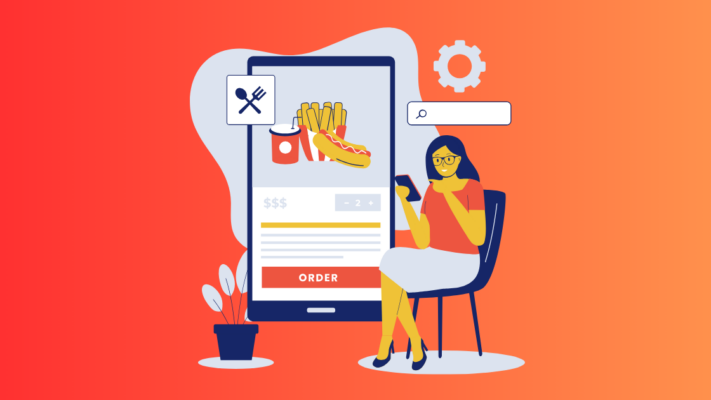The online food delivery market is rapidly booming and is anticipated to demonstrate a compound annual growth rate (CAGR 2024-2028) of 10.06%, leading to an estimated market size of US$1.79 trillion by 2028. In this ever-expanding market, players like DoorDash are leading the charge. But what if you have a fantastic idea for a niche food delivery app and a limited budget? Don’t worry, creating a budget conscious DoorDash clone is definitely achievable.
This guide will walk you through the key steps, focusing on cost-effective solutions for building a budget-conscious DoorDash clone.
-
Planning Makes Perfect
Before diving into development, conduct thorough market research. Analyze existing DoorDash clones and identify gaps they still need to address. Is there a specific cuisine missing? A particular delivery speed niche? Focusing on a unique selling proposition (USP) will help you stand out and attract a loyal customer base.
-
Choosing Your Delivery Model
There are three main delivery models to consider:
Aggregation: This is the most budget-friendly option. You partner with existing restaurants that handle order preparation and delivery through their own staff. Your app focuses on order processing and customer interaction.
Inventory: You manage a physical or virtual inventory of pre-made meals or partner with ghost kitchens (delivery-only kitchens). This requires upfront investment but allows greater control over quality and delivery times.
Hybrid: A mix of aggregation and inventory allows you to cater to a wider audience while offering faster delivery for specific items.
For a budget-friendly approach, start with the aggregation model. You can gradually integrate your DoorDash clone app with inventory management features later on.
-
Prioritizing Features for Your DoorDash Clone
While feature overload can be tempting, prioritize functionalities that enhance user experience and streamline operations. Here are some essentials:
Customer App:
- User-friendly interface for browsing menus, placing orders, and real-time order tracking.
- Secure payment gateway for in-app transactions.
- Push notifications for order status updates and promotions.
- Customer reviews and ratings for restaurants.
Restaurant App:
- Order management system to accept, confirm, and prepare orders.
- Real-time communication with delivery drivers.
- Analytics dashboard for tracking sales and customer behavior.
Delivery Driver App:
- GPS navigation for efficient deliveries.
- Order details and customer information.
- In-app communication with customers and restaurants.

-
Choosing the Right Development Path
There are three main approaches to consider for the development of your DoorDash clone:
In-house Development: Ideal if you have a team of experienced app developers readily available. However, this can be expensive, especially for ongoing maintenance.
Freelance Developers: This can be a cost-effective option, but finding reliable and skilled freelancers takes time and effort.
Low-code/No-code Platforms: These platforms offer drag-and-drop interfaces for building basic apps. While not ideal for complex functionalities, they can be a budget-friendly starting point, especially for MVP (Minimum Viable Product) development.
-
Keeping Costs Under Control
Here are some strategies to keep your DoorDash clone script development budget in check:
Prioritize Core Features: Start with the essential functionalities and add more later based on user feedback and market demand.
Open-Source Technologies: Utilize open-source libraries and frameworks whenever possible to reduce licensing costs.
Phased Development: Develop your DoorDash clone in stages, launching an MVP first and then adding features iteratively based on user feedback.
Consider a Cross-Platform Approach: Building a single app codebase that works on both iOS and Android can be more cost-effective than developing separate native apps for each platform.
-
Don’t Skimp on Testing and Security
While budget is a concern, thorough testing is crucial. Invest time in ensuring your DoorDash clone functions flawlessly across different devices and operating systems. Additionally, prioritize robust security measures to protect user data and financial information.
-
Marketing and User Acquisition
An excellent food delivery app script needs a solid marketing strategy. Harness social media platforms and forge local partnerships to connect with your intended audience. Consider offering launch discounts and referral programs to incentivize early adopters.
Wrap-Up: Scaling Your DoorDash Clone for Market Dominance
Building a successful DoorDash clone on a budget requires careful planning, prioritizing features, and adopting cost-effective development strategies. By focusing on a strong USP, user experience, and efficient operations, you can create a compelling food delivery app that thrives in the competitive market.
Ready to step into this highly profitable food delivery arena by developing a cost-effective food delivery app? Bytesflow Technologies is at your service.
We offer tailored white-label on-demand delivery app development solutions designed to meet your specific needs. Let’s collaborate to create your DoorDash clone app efficiently and navigate the market with confidence!
WhatsApp: +918610370937
Mail: [email protected]
Aparna Babukuttan is a content writer at Bytesflow Technologies who writes with passion and emotions. She has a keen interest in exploring the latest technologies and has years of experience in writing for artificial intelligence and Web3 including blockchain, NFT, metaverse, and cryptocurrency. Beyond Blockchain, Aparna also lends her expertise to crafting captivating narratives for on-demand food delivery businesses.








